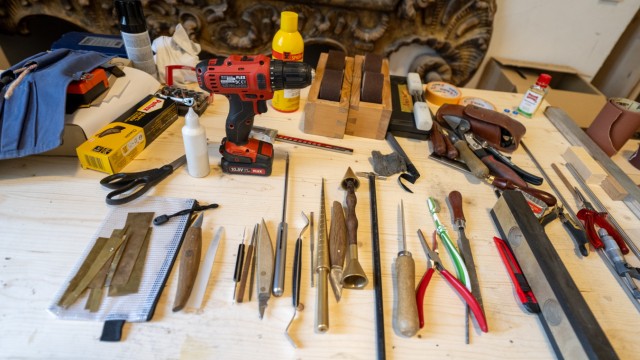It won’t be long before Philomela, Piffaro and Fugara will be playing together. That means they’re already doing it now, but when Stephan Niebler gets to them again, they’ll do it the way you want them to: precise, homogeneous, with a sensitively mixed timbre. Because Philomela, Piffaro and Fugara are not commedia dell’arte characters. The resounding names refer to registers of the new choir organ, which fundamentally changes the sound possibilities of the Munich Church of St. Michael.
On the wooden table next to the choir rehearsal room there are delicate pliers, spatulas, files, cones, knives and drills. Dental tool that performs work where a millimeter or not can mean the world.
Stephan Niebler has acquired acoustic expertise and craftsmanship over the course of over two decades as an intonator. He sang at St. Stephen’s Cathedral in Vienna and at Mainz Cathedral. Now he climbs the narrow staircase into the jungle of maple, spruce and metal pipes, which are assigned to one of the organ’s so-called works, the choral work. He has a small manual on his cell phone that lets him play the pipes. “A bit of wind,” says Stephan Niebler.
He takes the two-meter-long metal tube from her bed and hits the lower end with a kulphorn. This makes the wind intake quieter. A different tone is struck. “It drags,” states the intonator. He takes one of the tools that looks like finer pain, the core beater, and works the inside of the pipe. “Now he’s on time.” Apart from the cell phone, little has changed in the technology of the intonator in the last five hundred years. Just over 1,300 pipes, spread over 22 registers, are adjusted in this way. The longest measures around five meters, the shortest ten millimeters.
Organ builder Stephan Niebler at work.
(Photo: Catherina Hess)
The Rieger pipes were installed in the church between November and February, a few days before the intonator got to work. He takes the decisive final step. The sound of the organ must match the church. Since it is a choir organ, it should primarily be used to accompany ensembles, for liturgical purposes, but can also be used as a solo instrument. The top manual of the instrument is therefore connected to the main organ of the church, as Peter Kofler demonstrates.
The organist from St. Michael sits down at the console, on which there is not a speck of dust, and shows what the choir organ is capable of – allowing sound to flow in from all sides. “You want even sound coverage,” says Kofler. “The choir organ is the extended arm of the main organ.” As an organist, he is primarily responsible for the tonal disposition. It should be a universally applicable instrument with an impact on the German-Romantic spectrum, but which also has its own personality. “The registers mix very well, but are characteristic,” he says with a slight South Tyrolean twist. “Just like in an orchestra, you also need good soloists.” Kofler plays a note in the clarinet register: “Not every church has a clarinet like that!”

The new organ is also visually impressive.
(Photo: Catherina Hess)
Peter Kofler is familiar with the process of installing an organ. He has been the organist of the Jesuit Church since 2008. In 2011 the main organ was reorganized and expanded. In times of shrinking communities, the question arises as to why Saint Michael is getting a new organ. “If everything works well together, then there is a great chance that people will come to church,” says Kofler.
The church, especially this church in Munich’s pedestrian zone, is an open space that benefits from excellent church music. Especially because with this organ, which has its console in the choir room, the organist is no longer invisible, but rather part of the singing community, in contact with everyone. “It’s not the case that the question is: Why is this needed?” says Kofler. The approximately 600,000 euros for the new instrument were raised primarily by a private donor who wishes to remain anonymous.

Sound craft: the tools of the organ builder.
(Photo: Catherina Hess)
“And the organ will stay for a long time,” says the church musician. There are organs on which music can still be played wonderfully, even hundreds of years after they were installed. The beginning of this era is marked by Choir Organ Week: On Sunday, April 7th, the new organ will be inaugurated in a celebratory service. In the afternoon of the same day, the French organist Olivier Latry will demonstrate the instrument’s range with works ranging from the Renaissance to the late Romantic period. Martin Sturm will organize an evening concert on Friday, April 12th, with works by Bach, Reger and Schubert, but above all improvisations, before the week closes with a concert on Sunday, April 14th. Peter Kofler will play works by Bach and the French Impressionists, among others. Admission to all events is free.
“The space envelops you with sound,” says Kofler, describing the changed situation of church music in St. Michael. Philomela and her siblings are waiting to be heard, freshly assembled and sound-tuned.

